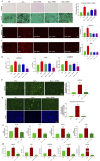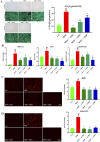The aldose reductase inhibitors AT-001, AT-003 and AT-007 attenuate human keratinocyte senescence
- PMID: 39741583
- PMCID: PMC11685203
- DOI: 10.3389/fragi.2024.1466281
The aldose reductase inhibitors AT-001, AT-003 and AT-007 attenuate human keratinocyte senescence
Abstract
Human skin plays an important role protecting the body from both extrinsic and intrinsic factors. Skin aging at cellular level, which is a consequence of accumulation of irreparable senescent keratinocytes is associated with chronological aging. However, cell senescence may occur independent of chronological aging and it may be accelerated by various pathological conditions. Recent studies have shown that oxidative stress driven keratinocyte senescence is linked to the rate limiting polyol pathway enzyme aldose reductase (AR). Here we investigated the role of three novel synthetic AR inhibitors (ARIs) AT-001, AT-003 and AT-007 in attenuating induced skin cell senescence, in primary normal human keratinocytes (NHK cells), using three different senescence inducing agents: high glucose (HG), hydrogen peroxide (H2O2) and mitomycin-c (MMC). To understand the efficacy of ARIs in reducing senescence, we have assessed markers of senescence, including SA-β-galactosidase activity, γ-H2AX foci, gene expression of CDKN1A, TP53 and SERPINE1, reactive oxygen species generation and senescence associated secretory phenotypes (SASP). Strikingly, all three ARIs significantly inhibited the assessed senescent markers, after senescence induction. Our data confirms the potential role of ARIs in reducing NHK cell senescence and paves the way for preclinical and clinical testing of these ARIs in attenuating cell aging and aging associated diseases.
Keywords: aldose reductase; aldose reductase inhibitors; oxidative stress; senescence; skin cell aging.
Copyright © 2024 Yepuri, Kancharla, Perfetti, Shendelman, Wasmuth and Ramasamy.
Conflict of interest statement
Authors RP, SS, and AW were employed by Applied Therapeutics Inc. The remaining authors declare that the research was conducted in the absence of any commercial or financial relationships that could be construed as a potential conflict of interest. The authors declare that this study received funding from Applied Therapeutics Inc. The funder had the following involvement in the study: editing the manuscript.
Figures





References
-
- Ananthakrishnan R., Kaneko M., Hwang Y. C., Quadri N., Gomez T., Li Q., et al. (2009). Aldose reductase mediates myocardial ischemia-reperfusion injury in part by opening mitochondrial permeability transition pore. Am. J. Physiol. Heart Circ. Physiol. 296 (2), H333–H341. 10.1152/ajpheart.01012.2008 - DOI - PMC - PubMed
LinkOut - more resources
Full Text Sources
Research Materials
Miscellaneous

